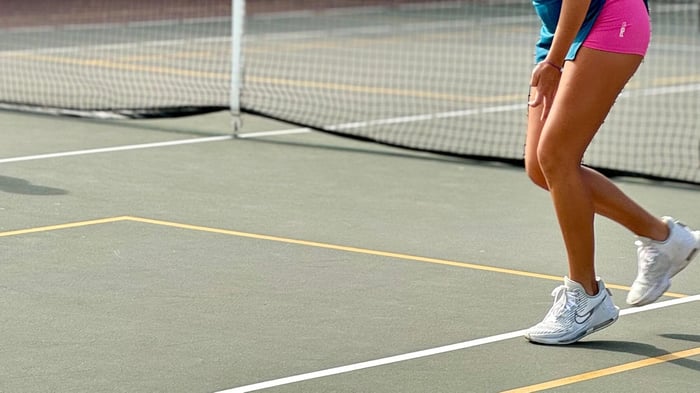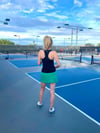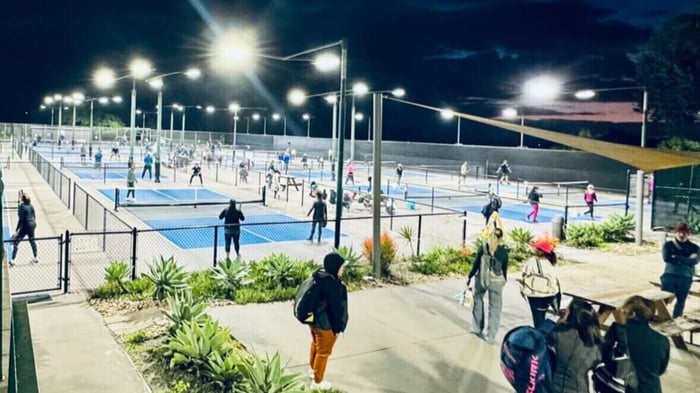Key takeaways:
Mastering footwork techniques like the split step, shuffle, and crossover can significantly boost your agility and reduce injury risk on the pickleball court.
Incorporating targeted drills into your training, such as lateral shuffles and balance exercises, enhances your agility, balance, and on-court performance.
Consistent practice using targeted drills builds muscle memory, sharpens reaction time, and reduces the risk of injury during gameplay.
Watching skilled players move across the pickleball court is like seeing a rhythm in motion. That fluidity comes down to foot placement. In pickleball, your feet do more than just get you from point A to B; they power every shot, every pivot, and every moment of strategic play. Lower body movement lays the groundwork for agility, helping players transition smoothly between offense and defense with balance, precision, and control.
Including core techniques like the split step, shuffle, and crossover can elevate your game while protecting your body. Inefficient movement wears players down and leads to early fatigue. That’s why smart footwork makes such a difference, paired with the proper support. At PB5Star, our PB5 Court2 Shoes are designed to support quick transitions and provide the stability needed for peak performance.
Starting with your stance
Quick movement starts before the first step; it begins with your stance. Stay grounded with knees slightly bent, weight on the balls of your feet, and your core engaged. This ready position keeps you light, balanced, and quick to react. Good footwork begins with being prepared for anything. The more consistently you return to this stance, the more control you'll have over your movement and momentum.
Your stance sets the tone for every point. A strong, athletic base helps you explode into motion, stay stable through tough rallies, and recover faster between shots. Think of it as your launchpad: confident, centered, and ready to move with purpose. Build it into muscle memory, which becomes the starting point for every clever play you make.
As rallies unfold, your ability to reset into a strong stance between shots becomes just as important as your initial position. After each movement, whether a lunge, pivot, or sprint, returning to your ready stance keeps you centered and responsive. It creates a rhythm of control, allowing you to manage momentum and maintain balance under pressure.
Targeted drills to improve your performance
Mastering footwork is essential for developing pickleball speed, balance, and precision. Targeted drills enhance movement efficiency and support better offensive and defensive play transitions. Players can improve their agility, reaction time, and court coverage by training specific movement patterns. The following exercises build a strong foundation for confident, controlled movement during gameplay:
Lateral shuffles
Improve your side-to-side movement to reach wide shots efficiently.
Set up markers five feet apart and shuffle them.
These shuffles increase your speed as you gain control.
Forward and backward sprints
Train your ability to switch between offense and defense.
These sprints mimic in-game transitions and build explosive movement in both directions.
Balance drills
Boost stability by practicing shots while standing on one leg.
These exercises help strengthen core control and prepare you for dynamic rallies.
Ladder drills
Increase foot speed and coordination with progressive patterns
Begin with two-foot hops, then advance to more complex sequences as your agility improves.
Cone drills
Set up cones in different shapes and practice quick directional changes.
This drill sharpens your control while simulating unpredictable in-game footwork.
Wall drills
Hit a ball against a wall while focusing on foot placement and recovery.
This drill improves timing, reaction speed, and shot accuracy for solo or supplemental practice.
Consistent footwork training plays a vital role in elevating overall pickleball performance. Players can develop quicker reflexes, stronger balance, and more efficient court movement by incorporating these drills into regular practice. These improvements contribute to greater consistency and confidence during matches. Over time, well-practiced footwork becomes second nature, forming the foundation for advanced gameplay.
How to avoid common footwork mistakes
Footwork is the engine behind every smooth pivot, quick recovery, and explosive rally. Refining your movement doesn’t just improve speed; it sharpens control, balance, and flow. Even seasoned players can make footwork mistakes that affect their game. Let's explore how to avoid footwork mistakes so that you can enjoy smoother, more confident play:
Stay in a ready stance to avoid being caught out of position.
Many players lose valuable time by standing too upright or flat-footed.
Keep your weight on the balls of your feet with your knees slightly bent.
This athletic stance helps you to react quickly and reach tough shots with better balance.
Adjust to the ball’s speed and spin to improve coordination and timing.
Stay active rather than rooted in place.
Move forward or backward based on the ball’s path instead of waiting for it to come to you.
Reading spin and pace early helps you anticipate shots and stay engaged during rallies.
Use split steps and shuffle steps to refine your footwork.
Perform a split step and light hop as your opponent hits to prepare for quick movement in any direction.
Shuffle laterally to stay balanced and avoid crossing your feet during wide shots.
These small movements build rhythm and make all transitions smoother between plays.
Incorporate footwork-focused drills into your routine.
Shadow drills: Move around the court without a ball, practicing footwork patterns.
Wall drills: Rally against a wall while focusing on foot placement and recovery.
Partner drills: Have a friend feed balls to different positions, helping you practice real-court movement while improving timing and teamwork.
Strong footwork is what turns effort into efficiency and potential into performance. The more you train your movement, the more confident and controlled your game becomes. Stay consistent and focused; every sharp step is progress, bringing you closer to your next personal best.
How to incorporate footwork drills into your training
Enhancing your agility in pickleball is an ongoing process. By incorporating footwork drills into your daily routine, you'll notice steady progress in your court coverage and overall gameplay. Begin by dedicating 10-15 minutes each day to focused movement practice. This consistent approach allows your muscles to adapt and your movements to become more fluid over time.
Wall drills offer a dynamic way to refine your court movement, agility, and reaction time, whilst using a structured plan to maintain focus and track your progress. Start each session with a quick warm-up, then move on to specific drills targeting different aspects of footwork. For instance, you might practice lateral shuffles on Mondays, forward and backward sprints on Wednesdays, and split-step exercises on Fridays.
Integrating these drills into your existing routine can be straightforward. When time is tight, try quick footwork exercises during breaks at work or while watching TV. You can also practice the ready position and split-step technique during everyday activities. By making moving practice a natural part of your day, we've seen players astonished at how swiftly their on-court performance improves.
Methods to track your footwork progress
Improving footwork requires more than repetition; it demands focus, structure, and consistent evaluation. Measurable progress builds confidence and reinforces the connection between movement and performance. With each session, purposeful training helps refine agility, reaction time, and overall efficiency on the court.
Set measurable goals to guide your footwork progress
Focus on specific areas, like lateral speed or split-step timing.
Create benchmarks such as reducing your side-to-side movement time by half a second.
Small, steady gains lead to noticeable improvements over time.
Drills that combine footwork with shot accuracy and decision-making make progress easier to track.
Use video analysis to review and refine your movement
Record your practice match or sessions for later review.
Watch for habits in positioning, reaction speed, and movement patterns.
Visual feedback helps identify minor adjustments that can significantly impact efficiency.
Assess your progress regularly for consistent results
Set a biweekly schedule to track your footwork through timed drills or performance metrics.
Logging progress helps highlight strengths and surface areas for improvement.
Structured practice enhances decision-making, court awareness, and movement flow.
Incorporate agility tests to challenge your footwork
Use the T-test to measure speed and control during directional changes.
Ladder drills and sprint-shuffle-sprint combos are great for practicing explosive movement.
These exercises keep your routine dynamic while developing quick transitions between plays.
Track physical performance as a measure of footwork gains
Use a training journal or app to monitor workout frequency, stamina, and intensity.
Note factors like reduced fatigue, quicker recovery, or longer sessions without slowing down.
Calorie burn and energy levels during play can signal improvements in agility and endurance.
Developing strong footwork is an ongoing process rooted in intention, consistency, and self-awareness. Tracking your progress over time creates space for steady improvement and a deeper understanding of your movement. These habits sharpen your performance and build a more confident, adaptable presence on the court.
Sample training schedule for all skill levels
Building strong footwork habits starts with a solid routine tailored to your skill level. Whether just starting or training at a competitive pace, structured sessions help you move with purpose and play confidently. From warm-up to cooldown, each training phase supports progress, prevents injury, and deepens your connection to the game. Here's how players at different levels can improve their footwork and enjoy the game even more:
Preparation and recovery: Start sessions with dynamic stretches and agility exercises for all levels. Conclude with static stretches and mobility work to prevent injuries and promote recovery. This routine sets the stage for enjoyable, injury-free play.
Beginners: Practice 3 times a week. Dedicate 30 minutes to fundamental drills like lateral shuffles and split-step exercises. These basics will help you move confidently on the court and connect with fellow players.
Intermediate: Train 4-5 times weekly. Spend 45 minutes on footwork-focused drills such as the 7-11 drill and cone exercises. You'll notice improved agility and more engaging rallies with your pickleball partners.
Advanced: Engage in high-intensity sessions 5-6 times a week. Dedicate 60 minutes to complex footwork drills, incorporating sprints and directional changes. Include wall drills to refine court movement and reaction time. Challenge yourself and inspire your pickleball community with your progress.
Community growth: Participate in small group coaching sessions to share experiences and strategies. These collaborative environments foster improvement and create lasting friendships on and off the court.
Consistent footwork training at every level builds a foundation for long-term improvement and confidence on the court. Structured routines help players stay agile, reduce injury risk, and maintain control during fast-paced play. Emphasizing preparation, recovery, and shared learning within the community supports personal growth and collective progress.
Your guide to better footwork
How can I set measurable goals for my footwork?
Start by pinpointing areas you want to improve, like lateral quickness or split-step timing. Set realistic benchmarks, such as shaving 0.5 seconds off your court-crossing time. These small wins build momentum and motivation. Over time, targeted goals turn into meaningful performance gains.
What tools can I use to analyze my footwork?
Video analysis is one of the most effective tools you can use. Record your games or practice sessions and review your movement closely. You’ll spot habits and inefficiencies that are hard to catch in the moment. Watching yourself play offers clarity that leads to smarter, sharper footwork.
How often should I assess my progress?
Consistency is key; assess your footwork every two weeks with timed drills or structured sessions. Keeping yourself accountable helps you notice speed, positioning, or endurance improvements. It also keeps your training intentional. Small check-ins add up to significant strides in performance.
Are there any specific agility tests I can use?
Absolutely. The T-test is a favorite for building lateral movement and court coverage. Add in ladder drills and forward-backward sprints for explosive transitions. These exercises train balance, reaction time, and rhythm. They also make your routine more interactive and fun to stick with.
How can I track my overall physical progress related to footwork?
You could use a fitness app or journal to log your workouts, noting things like stamina, energy levels, or how long you can play without tiring. You’ll start to see patterns that show your growth. Improved endurance often signals better movement efficiency. Celebrate every gain; it all adds up to stronger play.
Enhancing your pickleball skillset
Mastering footwork is your pathway to excelling on the pickleball court. Integrating targeted drills into your routine and honing your agility, balance, and swift movements will transform your gameplay. Consistent practice of wall drills can refine your court positioning and reaction time, while proper footwear provides the foundation for these improvements.
With time, these focused efforts build sharper physical skills, greater confidence, and court awareness. Every movement becomes more intentional, every step more efficient, and every rally more rewarding. As you commit to your training, remember that progress comes from consistently showing up and moving purposefully. At PB5Star, we design performance gear that supports every stride, helping you stay agile, balanced, and ready for whatever the game brings.







